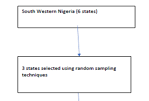Knowledge, Perception and Utilization of Herbal Medicine in Treatment of Malaria in Southwestern Nigeria

Abstract:
Malaria
control has been a challenge around the world for decades. In malaria endemic nations
like Sub-Saharan Africa, traditional herbal medicine is the most common option for
treating malaria. About 80% of the world's population relies on the use of herbal
medicine to treat a variety of diseases, and the use of plant materials in the treatment
of illnesses has continuously expanded. This study sought to assess the level of
knowledge and attitudes towards the use of traditional medicine in the treatment
of malaria in southwest Nigeria. Descriptive design and multistage sampling techniques
were utilised. During the first stage, three States were chosen through a balloting
process utilising random sampling methods. Four (4) sections of the questionnaire
were used to collect sociodemographic data and other factors that were important
to the achievement of the given objectives. The findings revealed that 31.7% of
the respondents had inadequate knowledge about traditional medicine for treatment
of malaria. 20.8% had positive perceptions to the common herbal medicines used in
the treatment of malaria. Majority stated malaria is not a serious disease to be
concerned about, and that traditional medicine is superior to modern medicine. Conclusively,
the results highlighted the respondent’s lack knowledge on the consequences of traditional
medicine. A strong correlation between traditional medicine uses and perception
in the treatment of malaria in southwest Nigeria was also discovered. The result
of the study prompted a recommendation that the public health department of the
ministry of health need to intensify campaign against use of unapproved herbs for
treatment of malaria.
References:
[1] World Health
Organization (2020) World Malaria Report 2020. World Health Organization, Geneva.
https://doi.org/10.30875/60123dd4-en.
[2] WHO. World
Malaria Report 2016. Geneva: World Health Organization; 2016.
[3] Awoselu
T.A, Ashikeni M.A, Envuladu E.A, Zoakah A.I. (2013). Perception and practice of
malaria prevention and treatment among mothers in Kuje Area Council of the Federal
Capital Territory, Abuja, Nigeria. Int J Med Biomed Res;2(3):213 – 220.
[4] Singh, S.
& Singh, R. (2014). Herbal Medicinal Treatment of Malaria in Aliero Local Government
Area, Kebbi, Nigeria. Journal of Medicinal Plants Studies. Volume: 2, Issue: 2.
Pp.117-126 ISSN: 2320-3862 Online Available at www.plantsjournal.com.
[5] Maximus,
M. T., Bambang, P. E.W. & Mangestuti, A., (2018). Plants used in traditional
medicine for treatment of malaria by Tetun ethnic people in West Timor Indonesia.
Asian Pacific Journal of Tropical Medicine. Vol. 11(11): pp.630-637 https://doi.org10.4103/1995-7645.246339.
[6] Mbah, G.O.,
and Ekweanya, N.M. (2019). Analysis of Utilization of Traditional Medicine for the
Treatment of Malaria among Rural Farmers in Abia State, Nigeria. International
Journal of Environment, Agriculture and Biotechnology (IJEAB) Vol-4, Issue- 2.
[7] Omagha R,
Idowu ET, Alimba, G.C, Otubanj, O.A., and Adeneye, Z.K. (2021) Survey of ethnobotanical
cocktails commonly used in the treatment of malaria in southwestern Nigeria.
Future Journal of Pharmaceutical Sciences 7:152.
[8] Beavogui
AH, Delamou A, Camara BS, Camara D, Kourouma K, Camara R, Djimde A (2020) Prevalence
of malaria and factors associated with infection in children aged 6 months to 9
years in Guinea: results from a national cross-sectional study. Parasite Epidemiol
Control 11: e00162. https://doi.org/1 0.1016/j.parepi.2020.e00162.
[9] Zachary,
M.L. (2003). Descriptive Statistics, Part II: Most Commonly Used Descriptive Statistics.
Journal for Specialists in Pediatric Nursing, 8(3).
[10] Mbah, G.O.,
and Ekweanya, N.M. (2019). Analysis of Utilization of Traditional Medicine for the
Treatment of Malaria among Rural Farmers in Abia State, Nigeria. International
Journal of Environment, Agriculture and Biotechnology (IJEAB) Vol-4, Issue- 2.
[11] Okosodo, E. and Sarada, M. (2021). Plants
traditionally used in treating malaria, typhoid fever, and related complications
in South-Western Nigeria. European Scholar Journal. 2(5).
[12] Beavogui
AH, Delamou A, Camara BS, Camara D, Kourouma K, Camara R, Djimde A (2020) Prevalence
of malaria and factors associated with infection in children aged 6 months to 9
years in Guinea: results from a national cross-sectional study. Parasite Epidemiol
Control 11: e00162. https://doi.org/1 0.1016/j.parepi.2020.e00162.
[13]
Adebayo JO, Krettli AU (2010) Potential antimalarials from Nigerian
plants: a review. J Ethnopharmacol 133(2):289–302. https://doi.org/10.1016/j.jep.
[14]
Oreagba
et al. (2011) Herbal medicine use among urban residents in Lagos, Nigeria. BMC Complementary
and Alternative Medicine.11:117.
[15]
Karunamoorthi, K., Jegajeevanram, K., Vijayalakshmi, J. &
Mengistie, E. (2012). Traditional Medicinal Plants: A Source of Phytotherapeutic
Modality in Resource-Constrained Health Care Settings. Journal of Evidence-Based
Complementary & Alternative Medicine 18(1) 67-74 SAGE. https://doi/10.1177/2156587212460241.
[16] Joseph, A., Nestor, G., Mark, A., and
Vincent, B. O., (2017). Malaria in Pregnancy: A Demographic and Clinical Surveillance
at Mother and Child Hospital Ondo, Southwestern, Nigeria. Journal of Prevention
& Infection Control. 2017, 3:1.
[17]
Eze,
B, Chuka-Okosa, C & Uche, J. (2013). Traditional eye medicine uses by newly
presenting ophthalmic patients to a teaching hospital in south-eastern Nigeria:
Socio-demographic and clinical correlates. Biomedical Centre Complementary and Alternative
Medicine.
[18] Yuan, H.; Ma, Q.; Ye, L.; Piao, G. The
traditional medicine and modern medicine from natural products. Molecules 2016,
21, 559.
[19]
Singh,
S. & Singh, R. (2014). Herbal Medicinal Treatment of Malaria in Aliero Local
Government Area, Kebbi, Nigeria. Journal of Medicinal Plants Studies. Volume: 2,
Issue: 2. Pp.117-126 ISSN: 2320-3862 Online Available at www.plantsjournal.com.
[20]
Suellen,
L., Odedina, S., Agwai, I., Ojengbede O., Huo, and Olopade, O. (2020). Traditional
medicine usage among adult women in Ibadan, Nigeria: a cross-sectional study.
[21]
Okosodo,
E. and Sarada, M. (2021). Plants traditionally used in treating malaria, typhoid
fever, and related complications in South-Western Nigeria. European Scholar Journal.
2(5).
[22]
Ogbuehi IH, Ebong OO, (2015). Traditional Medicine Treatment
of Malaria in Onitsha, Southeast Nigeria. Greener Journal of Medical Sciences,
5(1):011-018.

